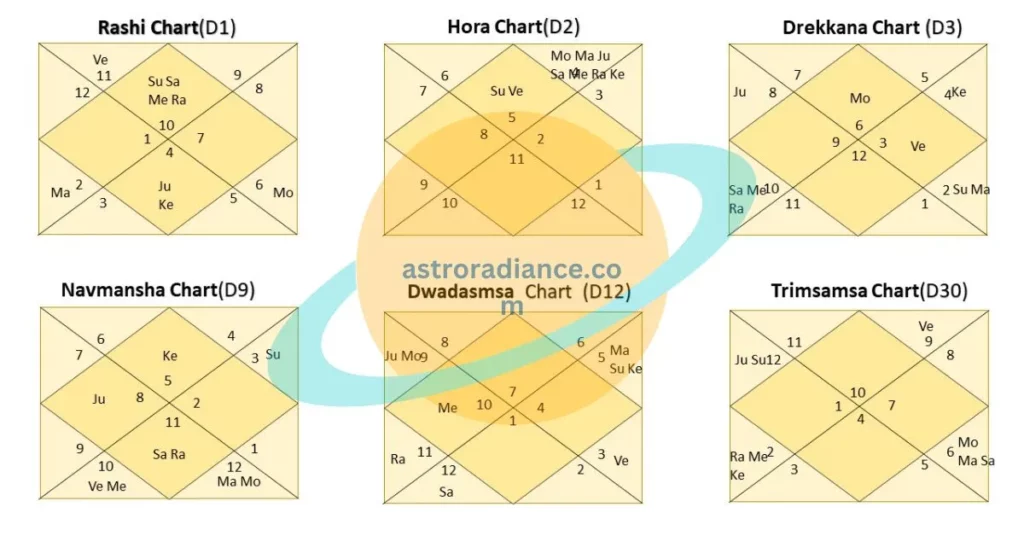Vimshopaka Bala is a way to measure the strength of the planets. Just as the strength of the planets is determined by the Shadbala, similarly, the strength of the planets is also determined by Vimshopaka Bala. While the method of Shadbala is quite complex and lengthy, the calculation of the strength of planets by Vimshopaka Bala is short and relatively easy.
Therefore, Vimshopaka Bala is the method of determining the strength of the planets, in which points are provided out of 20 based on different divisions of the planets in divisional charts. The more points a planet gets, the higher its Vimshopaka Bala.
The word Vimshopaka is derived from ‘Vinshti‘, a Sanskrit term meaning 20. Just as the 100th part of something is called a percentage, similarly, 20 is considered a unit and is referred to as Vimshopaka or Vishwa (Biswa).
Vimshopaka Bala in different Divisions
In the Brihat Parashara Hora Shastra, Vimshopaka Bala is determined for various divisions such as Shadvarga, Saptavarga, Dasvarga, and Shodashavarga. According to their importance in different divisions, they are assigned the following points:

After the Rashi Chart in the Shadvarga, the most importance is given to the D9, followed by the Drekkana horoscope. The values of the Vimshopaka Bala in the Shadvarga are 6, 2, 4, 5, 2, and 1 respectively. After the Lagna horoscope (D1), the most importance is given to the Navamsha (D9).
In Saptavarga, their weightage is 5, 2, 3, 2.5, 4.5, 2, and 1 respectively. Even after the Rashi Chart(D1), the most importance is given to the Navmansha(D9).
In the Dashavarga, 3 is for the Rashi Chart, 5 for Shashtiyamsha, and one and a half for the rest.
In the Shodashavarga, Hora 1, Trimsamsa 1, decanate 1, Shodasamsa 2, Navamsa 3, Rashi 3.5, Shashtiamsa 4, and the remaining nine divisions each receive half. The Vimshopaka strength remains at 20.
The figure against each individual division is called “Swaviswa“. For example, in the Rashi Division under Shodashavarga, you find 3.5, which is the Swaviswa.
“Varga Viswa” is the total strength of the planet, for various dignities such as placement in its own house, an great friend’s house, etc.
If a planet is continuously in its own Vargas throughout the Shad Varga scheme or any other, it receives all 20 points or the full Vimshopaka strength. However, this is not always possible. Due to placement in houses other than its own, the points diminish.
Calculation of Vimshopaka Bala
To find the net Vimshopaka, note the following formula:
Vimshopaka Bala = (Swaviswa * Varga Viswa) / 20
The calculation of Vimshopak Bala begins by examining the position of the planets in various divisions first. If we determine the strength of a planet in the Shad Varga, we need to look at its position in the Rashi Kundali, Hora, Drekkana, Navamsha, Dwadashamsha, and Trimsamsa Charts to see if it is in its Own sign or the signs of friends or enemies. This figure against each individual division is called “Swaviswa“
The presence of a planet in various divisions is given importance as follows:
Own sign (20) > Great friend (18) > Friend (15) > Neutral (10) > Enemy (7) > Great enemy (5)
If a planet is in its own division, it receives 20 points; if in the division of an exalted friend, it receives 18 points; if in the division of a friend, it receives 15 points; if in a neutral division, it receives 10 points; if in the division of an enemy, it receives 7 points; and if in the division of an exalted enemy, it receives 5 points. These are known as Varga Viswa.
By multiplying the total strength of the division (Varga Viswa) in that division by the division’s total points(Swavishwa) and then dividing by 20, the Vimshopak Bala of that division is determined. In this way, by calculating the Vimshopaka Bala for all divisions of a planet and adding them together, the total Vimshopak Bala of that planet can be determined.
Example Chart:

In the given example Kundali, we will calculate the Vimshopaka Bala for Saturn in its Shadvarga.
In the Rashi Kundali, Saturn is in the Capricorn sign, so its Varga Viswa is 20. Therefore, 6 * 20/20 = 6 Vimshopak Bala.
In the Hora, Saturn is in the sign of the Moon, which is an enemy sign, so its Varga Viswa is 7. Therefore, 2 * 7/20 = 0.7 Vimshopak Bala.
In the Drekkana, Saturn is in the Capricorn sign, which is its own sign, so its Varga Viswa is 20. Therefore, 4 * 20/20 = 4 Vimshopak Bala.
In the Navamsha, Saturn is in the Aquarius sign, which is its own sign, so its Varga Viswa is 20. Therefore, 5 * 20/20 = 5 Vimshopak Bala.
In the Dwadashamsha, Saturn is in the Pisces sign, which is a neutral sign, so its Varga Viswa is 10. Therefore, 1 * 10 /20 = 1 Vimshopaka Bala.
In the Trimsamsa, Saturn is in the Virgo sign, which is its own sign, so its Varga Viswa is 15. Therefore, 0.75 Vimshopaka Bala.
Therefore, in the given Kundali, the Vimshopaka Bala for Saturn is 6 + 0.7 + 4 + 5 + 1 + 0.75 = 17.45 Vimshopaka Bala.
Similarly, Vimshopaka Bala can be calculated for a planet in its Saptavarga, Dashavarga, and Shodashavarga.
Use Of Vimshopaka Bala
The use of Vimshopaka Bala is to determine the strength of the planets. If the Vimshopaka Bala of a planet is less than 5, it is considered incapable of producing results. If the Vimshopaka Bala is between 5-10, it produces minimal results. If it falls between 10-15, it produces moderate results. And if it is between 15-20, it is capable of producing full results.
By using Vimshopaka Bala, we can determine what kind of results a planetary dasha or antardasha will yield for an individual.

